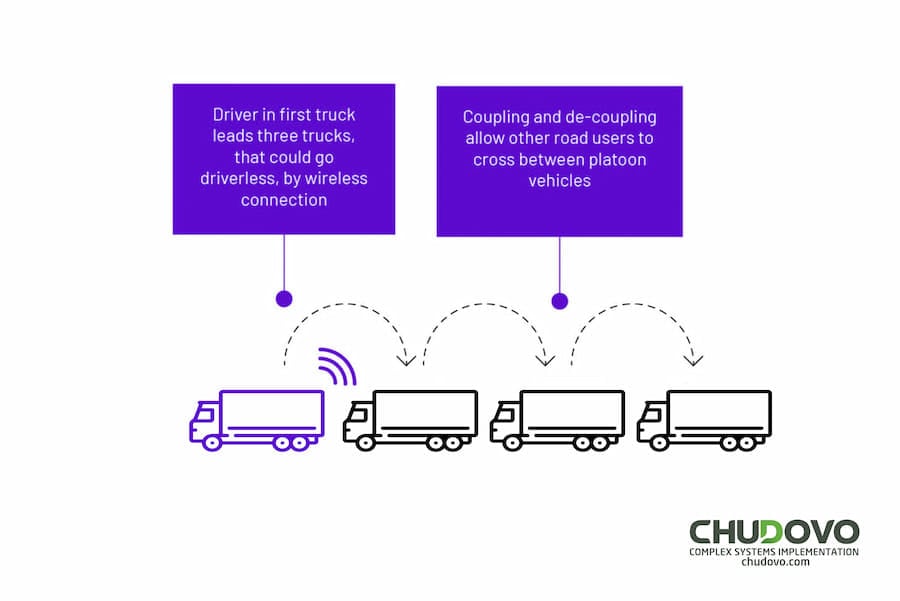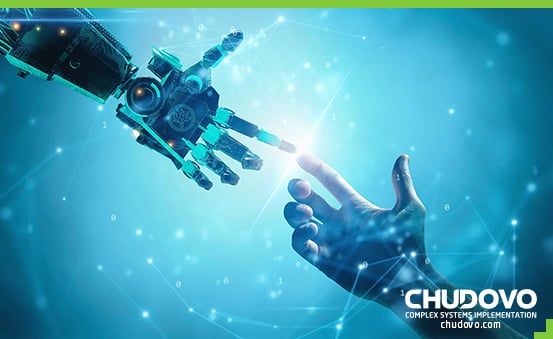Artificial Intelligence and Transportation – How the Future of Transportation Will Change
The transportation system refers to how goods and people are conveyed from one location to another across land, sea, air, and space. Currently, the transportation industry consists of more traditional methods of transportation, including cars, trucks, trains, motorcycles, helicopters, ships, boats, airplanes, etc.
Businesses, private individuals, and governments all make use of these modes of transport, and these can often experience issues with traffic management and road accidents. While some quarters are content with depending on driver education, traffic lights, and traffic wardens, there’s a more efficient way of boosting transportation efficiency. And that’s where artificial intelligence (AI) in transportation comes in.
Artificial intelligence simulates human thought to think and perform certain tasks that would normally require human intelligence. There have been sizable strides in how we use AI in transportation, but there’s more in store for the future. In this article, we’ll cover how artificial intelligence can change the future of the transportation industry.
Table of Content
How Can AI Work With Other Tech In Transportation?
When you mention artificial intelligence in a crowded room, what some people envision is a robot taking over everybody’s jobs. While that’s not completely far-fetched, AI is far more expansive than simply dialing it down to robots.
Artificial intelligence has several branches of technology including machine Learning, deep learning, natural language processing, robotics, expert systems, and fuzzy logic. Of all six, machine learning is most prominent in the usage of AI in transportation service delivery.
In addition to how machine learning is implemented in transportation, let’s take a look at how other forms of tech such as big data and Internet of Things (IoT) can work hand-in-hand with AI in transportation.
Machine learning, AI, and transportation
Machine learning is a means of analyzing data whereby the computer utilizes certain statistical models to form algorithms that represent how data sets occur. Using the information and algorithm realized, the computer program can predict how data variables will behave given the same circumstances.
Using machine learning, organizations, businesses, and governments can find solutions to transportation challenges. Coupled with machine learning, artificial intelligence can proffer solutions to a range of challenges, including understanding traveler behavior to set prices for ride-hailing services.
Big data analytics and AI in transportation
Big data analysis is the use of advanced data analysis methods to analyze large amounts of data across various data sources and types. From purchasing patterns to global data about travel and transportation, AI and big data analysis can help large corporations and governments to make relevant decisions faster.
IoT and AI in Transportation
The Internet of Things (IoT) is a network of interconnected devices that communicate and share information between themselves without the need for human intervention or interference. It can be used in tracking devices for transportation vehicles and logistics of goods and services.

Artificial Intelligence and Transportation
Examples of AI in Transportation
The latest AI technologies make the logistics industry more automated and user-oriented. Below are some of the up-and-coming examples of Artificial Intelligence in transportation.
- Waymo – A commercial taxi service that provides autonomous cars in its fleet. Its actually one of the first of its kind to provide fully autonomous rides to customers. Think of Uber but without human drivers.
- Integrated roadways – Connect vehicles to collect and provide information about traffic congestions, accidents, road conditions and quality, and more, through its smart pavement system. The good thing about these smart pavements is that they last longer than roads built with traditional asphalt and concrete.
- Transmetrics – An artificial intelligence platform that uses predictive analytics and machine learning to aid transport and logistics planning. The result is an improvement in operational efficiency and reduced environmental impact.
- Hitachi – Multinational company that integrates artificial intelligence in transportation by collecting and analyzing data which enhances advanced predictive fleet maintenance, monitoring, and health of assets on board.
How will AI change Transportation in the future? – AI in Transportation Use Cases
Artificial intelligence, in some cases, can potentially replace the need for human workers in certain jobs in the future. We’re already seeing this with services such as Waymo, which replaces human drivers with autonomous, self-driving vehicles that can carry passengers around using AI.
How else can artificial intelligence affect the future of the transportation industry? Take a look at these use cases:
Autonomous, self-driving vehicles
Autonomous vehicles are self-driving cars that do not need the expertise of a human driver. These vehicles will combine the power of artificial intelligence with engineering, cameras, and sensors to navigate from one point to another. Currently, there are a number of car and vehicle manufacturers who are developing and testing self-driving cars for the commercial market, including BMW, Tesla, and Waymo.
Of course, there have been concerns about the security capabilities of such vehicles and their ability to keep passengers safe. However, constant testing and research will see autonomous vehicles become safer than those driven by human drivers. Overall, we should see a reduction in frequent road accidents and a global increase in the production and adoption of self-driving vehicles.
Traffic management
Big, populated cities have one thing in common – traffic congestion. Using cameras and sensors, AI can collect data on traffic situations, analyze them with big data analysis, provide commuters with valuable insight into traffic conditions and suggest the fastest routes to follow.
In a way, Google Maps traffic and route prediction do this. But the Google Map method is flawed because it only uses phone GPS tracking to predict traffic congestion. This can be inefficient and inaccurate in situations where the actual number of vehicles on the road is more than the number of smartphones.
Predicting flight delays
Flight delays are costly both to the airlines and passengers. With AI, airlines can monitor regular culprits of flight delays, such as weather conditions, air traffic congestion, go-arounds, and mechanical delays, to prevent the loss of time and resources due to flight delays. Aside from the obvious causes of flight delays, artificial intelligence can also be implemented to predict unforeseen circumstances that can affect flight schedules.
Fleet operation and management
The global pandemic revealed the need for more efficient logistic services. Many organizations operating with large fleets would need a system that allows all moving parts to work seamlessly and efficiently. From tracking and communication between drivers and fleet managers, AI can provide real-time updates, simplify data management, and provide insight into problematic areas.
Digital number plates for cars
Toll gates and fees are a source of traffic congestion in certain populated areas. Commuters spend time at the gates trying to pay cash or swipe a card before they can be allowed to pass, essentially delaying other drivers behind them. With AI-powered digital number plates, governments and businesses can tie several services to the number plates including payments for tolls.

Certified engineers
Convenient rates
Fast start
Profitable conditions
Agreement with
EU company
English and German
speaking engineers
Not only will it reduce toll gate wait times, it also helps to reduce car theft cases and other vehicle-related crimes because sensors and traffic cameras would be able to track the number plates wherever it appears. Overall, it’s super convenient, heightens security, and would no doubt influence transportation in the coming future.
AI Police Vehicles
This is also a form of autonomous vehicle, as these AI police cars do not have drivers. They can issue parking and speeding tickets, read license plates, use thermal imaging, access CCTV footage, and lots more. Dubai is already implementing smart police cars into its police force operations.
Benefits of Artificial Intelligence in Transportation
When artificial intelligence is combined with big data analytics, the internet of things, and machine learning, amazing solutions can be developed. Here are some benefits of using AI in transportation:
- Vehicle tracking
- Efficient use of storage capacity
- Reduction of operational costs
- Route optimization for logistics
- Reduction in traffic accidents
- Increase sustainability
- Reduction in commute time
Vehicle Tracking
AI combined with the Internet of Things sensors enables logistics and transport companies to track their vehicles and assets along every journey. All they’ll need to do is attach these sensors to the vehicles and remotely monitor the condition and location of these vehicles from the office or station.
With AI in transportation, fleet managers at logistic companies can stay in constant communication with the riders and drivers on the field. They can let them know if they need to avoid certain routes, cancel a delivery, or return to base. They can also track the vehicle’s speed, location, and direction.
And if the vehicles are carrying perishable or valuable items that have special storage requirements, the IoT sensors can transmit information about the current state of the storage containers and the asset themselves. This way, the company can minimize wastage, contamination, and compromise of assets during transport.
Efficient use of storage capacity
Companies that need to transport large amounts of packages and assets regularly have to decide on how to store and position these goods in such a way that optimizes the storage space in their delivery trucks. Using artificial intelligence, these companies would be able to know the best combinations and positions of the product that best optimizes the available space.
If they would ordinarily use five trucks to deliver some items, AI can enable them to reduce it to three trucks by optimizing the space available. This means less maintenance cost, less running costs, more trucks to use on other deliveries, and less time spent on the road.
Reduction of operational costs
When companies tap into the power of AI to optimize their operations, they’ll be able to cut down on activities that increase costs and pinpoint where to improve efficiency to save time and be more productive. They’ll spend less on operational costs such as vehicle maintenance fees, salaries for drivers, production costs, etc.
Route optimization for logistics
When a company needs to move a large number of packages from point A to B, it becomes more complicated to figure out the best route for the operation. But they can use AI in transportation to analyze big data and determine what the best route and delivery method would be, hence, optimizing the route to reduce shipping and transportation time and speed up delivery.
Reduction in road accidents
More accidents happen at night compared to other times of the day. And since AI-powered autonomous vehicles have a higher chance of keeping passengers and goods safe, it makes sense that more self-driving cars or vehicles with autopilot features will be rolled out in the coming years. Truck drivers can take a few minutes to snooze and recharge while AI takes over at night.
Also, human error is responsible for a large chunk of road accidents. By implementing AI in transportation, countries can reduce the number of road accidents by a wide margin. When done long enough and the right way, governments can continually and increasingly keep lives and property safer on the road.
Increase sustainability
Artificial intelligence can help the transportation industry to reduce pollution from vehicles on the land, sea, and the air by developing more efficient ways to run these types of machinery for transporting goods and services. This would mean a reduction in carbon emissions, less pollution, and a safer environment for all.
Reduction in commute time
With AI in technology, commuters will be able to check for accidents, road blockages, and congestion along their route. They can also reduce commute times by following the AI-suggested routes for their journey.
Disadvantages of AI in transportation
We know the advantages, but for a robust experience and round knowledge, you’ll also need to know about the disadvantages of implementing artificial technology in transportation systems, locally and internationally. Here are a few of them:
- Cybersecurity isn’t 100%
- AI traffic management is costly
- AI isn’t totally independent
- Potential to replace blue-collar workers
- Increase in energy consumption
Cybersecurity isn’t 100%
AI mostly works over the cloud, transferring information from one point to the next through the internet. While this is important for some device functions like censor cameras and AI vehicles and more, it also poses an opportunity for hackers to intercept the communication and hack the system. If a hacker were to hack the controls of a self-driving car and take over the control of the vehicle, that could spell doom for the AI self-driving car space.
AI traffic management is costly
AI-based systems for traffic management that can support self-driving vehicles are costly investments to make. Smaller communities and cities with limited resources might not adopt AI as quickly as other communities that can afford it easily. Aside from these, some countries or cities do not yet have the infrastructure to support self-driving cars, so if they decide to switch to it, they’ll need to install suitable infrastructure to support the usage.
AI isn’t totally independent
Despite the fact that AI can mimic human intelligence and reduce the error margin, it cannot totally replace it across the board. To ensure the system works efficiently and as intended, it needs human control, assistance, and monitoring, especially at the initial stages. In case of a system error or malfunction, a human supervisor would still need to keep an eye on its operations.
Potential to replace blue-collar workers
The main purpose of artificial intelligence is to learn and mimic the intelligence of humans without allowance for human error to accomplish tasks more efficiently. Unfortunately, what this means is that businesses that use self-driving vehicles, for example, would no longer require the service of truck drivers. Although this invention might spark job creation at the top where the thinkers work, the blue-collar drivers may be out of jobs and too far down the qualification chain to get a job at the top.
Increase in energy consumption
Artificial intelligence tech has the potential to increase efficiency within the system it integrates and is used for. This can help organizations save time and resources. However, where they spend less on time and other costs, energy consumption can become another leaking tap.
As AI implementation gains prominence, the systems will require more processing power and consume more power to run the devices. Hence, the devices will have to use energy and power more intelligently and efficiently to harness all the potential of AI.
Conclusion
The transportation industry across the world faces a number of issues that need innovative problem-solving. From traffic congestion to flight delays, automotive crimes, high operational costs, hectic fleet management, and so much more, artificial intelligence can be implemented to tackle these issues experienced in transportation. By implementing and integrating artificial intelligence, businesses, organizations, individuals, and governments can achieve more results and become more efficient in their operations. Nowadays AI has penetrated countless industries. Artificial intelligence revolutionizes sports, medtech, fintech, retail, and more.
Based on current information, it’s obvious that artificial intelligence has found its place in global, international, and local transportation and is changing the future of transport. The question you need to answer is how you can best key into the changes AI will bring. Will you be a provider, partner, or consumer?




